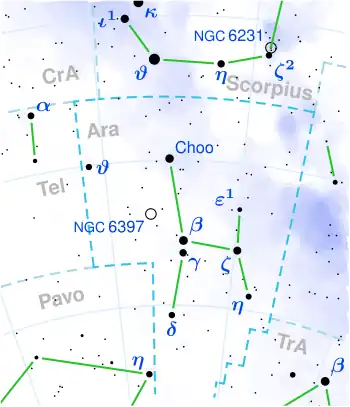Pi Arae
Pi Arae, Latinized from π Arae, is the Bayer designation for a star in the southern constellation of Ara. It is faintly visible to the naked eye with an apparent visual magnitude of +5.25.[2] Based upon an annual parallax shift of 46.30 mas as seen from Earth,[1] it is located 70 light years from the Sun. It is most likely moving closer to the Sun with a radial velocity of −3 km/s.[4]
 | |
| Observation data Epoch J2000.0 Equinox J2000.0 (ICRS) | |
|---|---|
| Constellation | Ara |
| Right ascension | 17h 38m 05.51512s[1] |
| Declination | –54° 30′ 01.5643″[1] |
| Apparent magnitude (V) | +5.25[2] |
| Characteristics | |
| Spectral type | A5 IV-V[3] |
| B−V color index | +0.20[2] |
| Astrometry | |
| Radial velocity (Rv) | −3.3±3.1[4] km/s |
| Proper motion (μ) | RA: +128.19[1] mas/yr Dec.: +62.16[1] mas/yr |
| Parallax (π) | 46.30 ± 0.19 mas[1] |
| Distance | 70.4 ± 0.3 ly (21.60 ± 0.09 pc) |
| Absolute magnitude (MV) | +2.01[5] |
| Details | |
| Mass | 1.73[6] M☉ |
| Radius | 1.90[7] R☉ |
| Luminosity | 13.3[5] L☉ |
| Surface gravity (log g) | 4.36[6] cgs |
| Temperature | 8,215±279[6] K |
| Metallicity [Fe/H] | +0.13[5] dex |
| Rotational velocity (v sin i) | 54.1±0.4[8] km/s |
| Age | 319[6] Myr |
| Other designations | |
| Database references | |
| SIMBAD | data |
The stellar classification of this star is A5 IV-V,[3] indicating the spectrum displays the hybrid features of both a main sequence and a more evolved subgiant star. Pi Arae is an estimated 319[6] million years old and is spinning with a projected rotational velocity of 54.1 km/s.[8] The star has 1.73[6] times the mass of the Sun and 1.90[7] times the Sun's radius. It is radiating 13.3[5] times the Sun's luminosity from its photosphere at an effective temperature of about 8,215 K.[6]
Pi Arae displays an excess emission of infrared radiation, which may be explained by circumstellar dust.[10] The thermal emission matches a two component model, consisting of an inner disk of warm crystalline silicate dust and an outer colder disk of dirty ice. The inner disk has a temperature of 173 K and is orbiting roughly 9.1 AU from the host star. The outer disk is 77 K and orbits at a distance of about 117.3 AU. The small size of some of the dust grains indicate the inner disk may have formed relatively recently from collisions between orbiting planetesimals.[11]
Located 55 arc minutes to the north of Pi Arae is the globular cluster NGC 6397.[12]
References
- van Leeuwen, F. (2007), "Validation of the new Hipparcos reduction", Astronomy and Astrophysics, 474 (2): 653–664, arXiv:0708.1752, Bibcode:2007A&A...474..653V, doi:10.1051/0004-6361:20078357, S2CID 18759600.
- Johnson, H. L.; et al. (1966), "UBVRIJKL photometry of the bright stars", Communications of the Lunar and Planetary Laboratory, 4 (99): 99, Bibcode:1966CoLPL...4...99J.
- Houk, Nancy (1978), Michigan catalogue of two-dimensional spectral types for the HD stars, vol. 1, Ann Arbor: Dept. of Astronomy, University of Michigan, Bibcode:1975mcts.book.....H.
- Gontcharov, G. A. (November 2006), "Pulkovo Compilation of Radial Velocities for 35495 Hipparcos stars in a common system", Astronomy Letters, 32 (11): 759–771, arXiv:1606.08053, Bibcode:2006AstL...32..759G, doi:10.1134/S1063773706110065, S2CID 119231169.
- Anderson, E.; Francis, Ch. (2012), "XHIP: An extended hipparcos compilation", Astronomy Letters, 38 (5): 331, arXiv:1108.4971, Bibcode:2012AstL...38..331A, doi:10.1134/S1063773712050015, S2CID 119257644.
- David, Trevor J.; Hillenbrand, Lynne A. (2015), "The Ages of Early-Type Stars: Strömgren Photometric Methods Calibrated, Validated, Tested, and Applied to Hosts and Prospective Hosts of Directly Imaged Exoplanets", The Astrophysical Journal, 804 (2): 146, arXiv:1501.03154, Bibcode:2015ApJ...804..146D, doi:10.1088/0004-637X/804/2/146, S2CID 33401607.
- Patel, Rahul I.; et al. (May 2014), "A Sensitive Identification of Warm Debris Disks in the Solar Neighborhood through Precise Calibration of Saturated WISE Photometry", The Astrophysical Journal Supplement Series, 212 (1): 23, arXiv:1403.3435, Bibcode:2014ApJS..212...10P, doi:10.1088/0067-0049/212/1/10, S2CID 119219094, 10.
- Díaz, C. G.; et al. (July 2011), "Accurate stellar rotational velocities using the Fourier transform of the cross correlation maximum", Astronomy & Astrophysics, 531: A143, arXiv:1012.4858, Bibcode:2011A&A...531A.143D, doi:10.1051/0004-6361/201016386, S2CID 119286673.
- "pi. Ara", SIMBAD, Centre de données astronomiques de Strasbourg, retrieved 2017-09-26.
- Morales, Farisa Y.; et al. (April 2011), "Common Warm Dust Temperatures Around Main-sequence Stars" (PDF), The Astrophysical Journal Letters, 730 (2): L29, Bibcode:2011ApJ...730L..29M, doi:10.1088/2041-8205/730/2/L29, S2CID 2360696.
- Morales, F. Y.; et al. (October 2013), "Herschel-resolved Outer Belts of Two-belt Debris Disks around A-type Stars: HD 70313, HD 71722, HD 159492, and F-type: HD 104860", The Astrophysical Journal, 776 (2): 13, Bibcode:2013ApJ...776..111M, doi:10.1088/0004-637X/776/2/111, 111.
- O'Meara, Stephen James (2013), Deep-Sky Companions: Southern Gems, Cambridge University Press, p. 358, Bibcode:2013dcsg.book.....O, ISBN 978-1139851541.